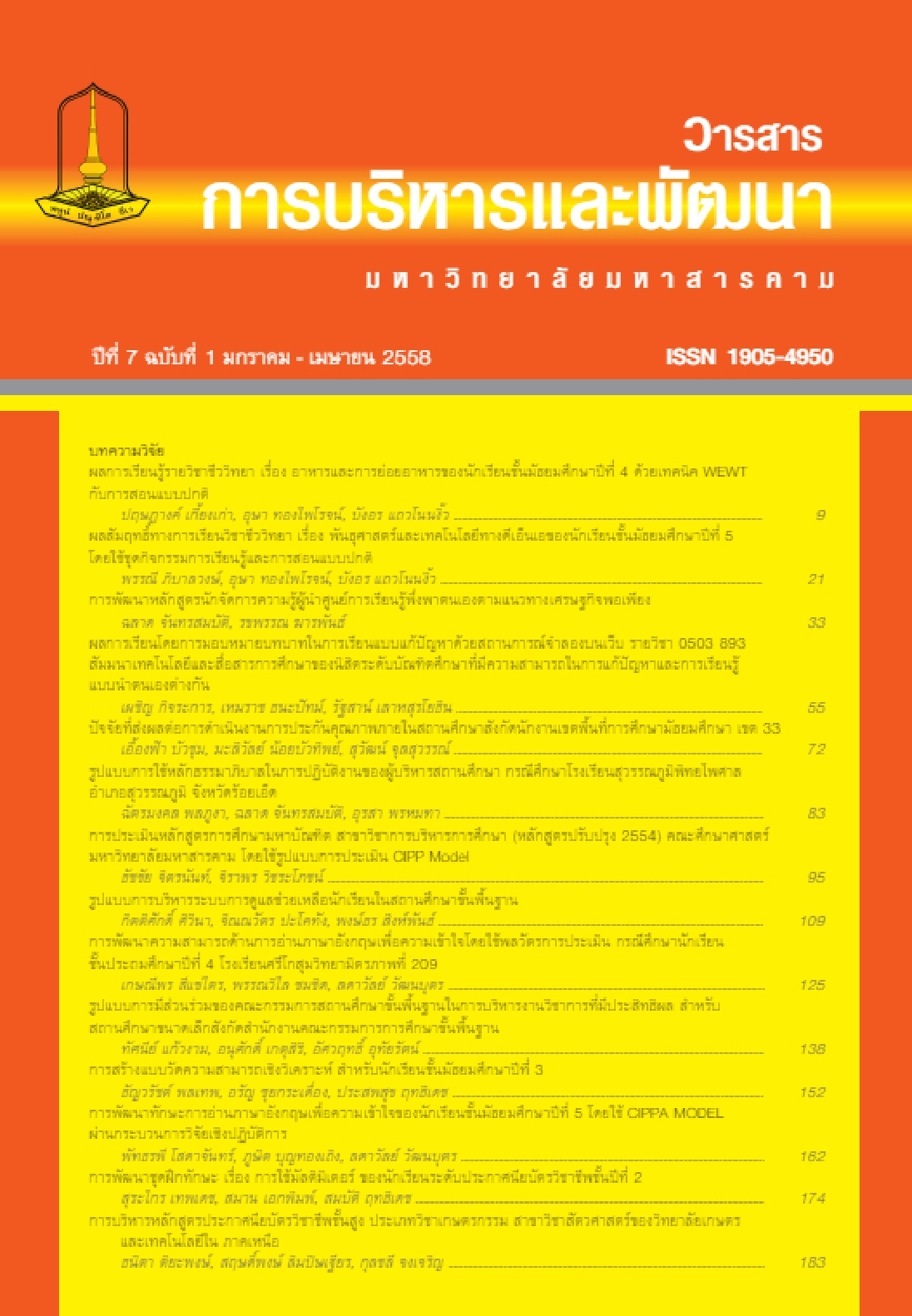The Development of English Reading Comprehension Ability by Using Dynamic Assessment: A Case Study of Grade 4 students Srikosumwittayamittrapap 209 School.
Main Article Content
Abstract
The purposes of this research were to: 1) develop the English reading comprehension ability by using dynamic assessment of Grade 4 students, 2) investigate the English reading comprehension ability among: pre - reading during and post- reading 3) investigate the students’ satisfaction on English reading - reading comprehension ability by using dynamic assessment. The sample used selected through purposive sampling, were 38 Grade 4 students at Srikosumwittayamittrapap 209 School, MahaSarakham Primary Educational Service Area Office 3 in the second semester of the 2012 academic year.The research instruments consisted of: 12 learning lesson plans, a 4 choices of 30 - item of reading comprehension achievement test and 10- item of a five rating scale questionnaire related to satisfaction of students towards the English reading comprehension ability by using dynamic assessment. The statistics used for data analysis were: percentage, means, standard deviation and t - test (Dependent sample).
The results of the research were as follows:
1. The English reading comprehension ability by using dynamic assessment of Grade 4 students was higher post- reading than pre-reading score with statistic significance at.01 and mean score of English reading comprehension ability pre-reading and post- reading at 8.34 and 24.24 2. The English reading comprehension ability by using dynamic assessment of Grade 4 students pre - reading, while - reading and post - reading was while - reading score and post - reading score were higher than pre - reading score at 11.42, 32.42 and 19.6. This presented that the students developed their English reading comprehension ability by using dynamic assessment at 57.1, 81.05 and 98.02 percent. 3. The satisfaction of Grade 4 students who had learned English reading comprehension ability by using dynamic assessment was rated at the highest level with mean score of 4.51.
Downloads
Article Details
References
Achara Wongsothorn. (1995). Language Test Construction Guideline. Bangkok: Chulalongkorn University Printing House.
Achara Wongsothorn. (2001). Testing and Evaluation of English Learning. 2nd ed. Bangkok: Chulalongkorn University Printing House.
Amonrat Kasemsuk, Thongsuk Wansan, and Somboon Satalalai. (2009). A Study of the English Learning Outcome of Matayom Suksa 3 Student by using KWL-Plus and a Conventional Method in Surin educational service area office 2. Graduate School Journal, Surindra Rajabhat University 3 (1): 1-7.
Anton, Marta. (2009). “Dynamic Assessment of Advanced Second Language Learners,” Foreign Language Annals. 42(3): 576-598 ; Fall
Kitjanat Tangjitnusorn. (2009). Study of Undergraduate Students’ English Reading Ability and Identity via Problem Solving Process on Hi5. Master of Education in Teaching English. Chiang Mai: Chiang Mai University.
Kozulin, A. and Grab, E. (2002). “Dynamic Assessment of EFL Text Comprehension of at-Risk Students,” School Psychology International. 23(1): 112-127
Maha Sarakham Primary Educational Service Area Office 3. (2011). Report of the Basic Education Assessment for Prathom Suksa 4 Students, Academic year 2011. Retrieved October 13, 2011, from www.mkarea3.go.th
Mardani, Mehdi and Manssour Tavakoli. (2011). “Beyond Reading Comprehension: The Effect of Adding a Dynamic Assessment Component on EFL Reading Comprehension,” Journal of Language Teaching and Research. 2(3): 688-696 ; May,
Maslow, Abraham. (1970). Motivation and Personality. 2nd ed. New York: Harper and Row Inc,
Moore Brown, Barbara, et al. (2006). Using dynamic assessment to evaluate Children with suspected learning disability. retrieved August 14, 2011, from http://www.highbeam.com
Nipaporn Promchuay, Panida Tipwichai, and Maneepat Bunchoo. (2009). The Effects of Using Dynamic Assessment on the Students’ Reading Ability. Independent Study in English. Pitsanulok: Naresuan University.
Pachongkarn Phuvipadawat. (1999). Development of Innovation in English Language Teaching for Dissemination. Chiang Mai: Department of Secondary Education, Faculty of Education. Chiang Mai University.
Phatcharaporn Boonthama. (2009). Use of the IDEAL Problem-Solving Strategy for Promoting English Reading Comprehension and Problem-Solving Ability of Mathayom Suksa 5 Students. Master of Education in Teaching English.Chiang Mai: Chiang Mai University.
Secondary Educational Service Area Office 26. (2010). National Test Results 2010. Kosumpisai: Maha Sarakham.
Surawat Thongbu. (2007). Educational Research. Maha Sarakham: Faculty of Education, Rajabhat Maha sarakham University.
Stanfa, Kathleen M. (2010). “Differentiating Among Students: The Value Added of a Dynamic Assessment of Morphological Problem Solving”. Dissertation Abstracts International. Pittsburgh: University of Pittsburgh,
Yildirim . (2008). “Vygotsky’s Sociocultural Theory and Dynamic Assessment in Language Learning,” Anadolu University Journal of Social Sciences. 8(1): 301-308.


